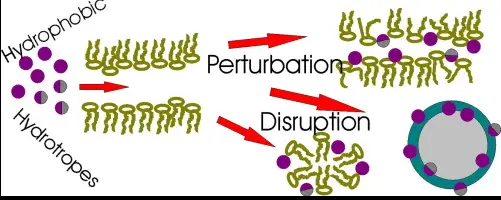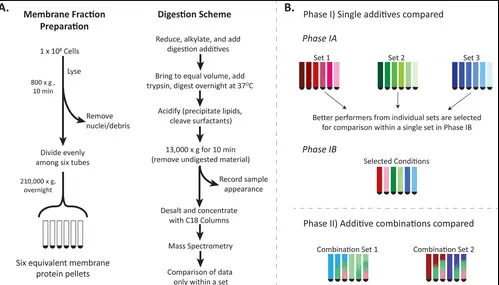Chemical agents such as detergents and chaotropic agents play critical roles across various scientific and industrial fields. Each possesses unique properties and functions that distinguish them from one another, often leading to confusion about their respective uses and effects. These agents, integral to molecular biology and biochemistry, facilitate diverse processes from cellular lysis to protein solubilization.
Detergents and chaotropic agents differ primarily in their chemical structures and mechanisms of action. Detergents are amphipathic molecules that solubilize fats and proteins by disrupting hydrophobic interactions, making them essential for cleaning and biochemical applications. Chaotropic agents, on the other hand, disrupt hydrogen bonding and water structure, thereby denaturing biomolecules and aiding in their manipulation and study.
These distinctions are not just academic but have practical implications in research and industry. Understanding their differences can enhance the effectiveness of experimental protocols and improve outcomes in applications ranging from pharmaceuticals to environmental science.

Detergent Basics
Definition and Properties
Detergents are chemical compounds that belong to a class known as surfactants. These substances have the unique ability to reduce the surface tension of water, making it easier for water to spread and mingle with oils and greases. A detergent molecule features a distinct dual nature: one part of the molecule is hydrophilic (water-loving), and the other part is hydrophobic (water-repelling). This duality allows detergents to attach to both water and oil molecules, effectively breaking down and removing dirt or other organic materials from various surfaces.
The properties of detergents make them ideal for cleaning applications, as they can interact with a wide range of organic compounds. Their effectiveness is enhanced by their amphipathic structure, allowing them to form micelles—a spherical arrangement where hydrophobic tails trap oil and grease inside, leaving the hydrophilic heads exposed to water. This action not only cleans surfaces but also keeps particles in suspension, preventing re-deposition.
Common Uses
Detergents serve a variety of functions across different industries, emphasizing their versatility:
- Household Cleaning: From dishwashing liquids to laundry detergents and all-purpose cleaners, detergents are fundamental in everyday household cleaning tasks.
- Industrial Applications: Used in heavy-duty cleaning of equipment, removal of oils and residues in manufacturing processes, and as components in other chemical processes.
- Biochemical Research: In labs, detergents are crucial for the extraction and purification of proteins and other cellular components.

Chaotropic Agents
Definition and Role
Chaotropic agents are chemicals that disrupt the molecular organization of water and alter protein structures. By interfering with the non-covalent bonds that maintain the stability of biological molecules, these agents can increase the solubility of otherwise insoluble substances. The primary role of chaotropic agents in scientific research is to denature proteins, facilitating easier study and manipulation.
Chaotropic agents work by weakening the hydrogen bonds between water molecules, thereby disrupting the hydrophobic interactions that help proteins maintain their three-dimensional structure. This process is essential in methods where the natural conformation of molecules poses a barrier to study or application.
Examples in Use
Chaotropic agents are utilized in various research and industrial applications, demonstrating their critical function:
- Nucleic Acid Extraction: These agents are vital in extracting pure nucleic acids by denaturing proteins and dissolving cell membranes.
- Protein Denaturation: In protein purification, chaotropic agents are used to unfold proteins, making them more accessible for analysis and modification.
- Environmental Science: They assist in studying the stability of biomolecules under extreme conditions, relevant to understanding biochemical cycles.
Key Differences
Chemical Structure
The chemical structure of detergents and chaotropic agents is fundamentally different, leading to their distinct behaviors. Detergents typically consist of a long hydrophobic chain and a hydrophilic headgroup, forming structures that encapsulate non-polar substances. Conversely, chaotropic agents often contain highly polar groups that disrupt hydrogen bonding in water, without forming micellar structures.
Mechanism of Action
The mechanism of action also varies significantly:
- Detergents: They clean by surrounding and isolating particles of dirt or oil, which are then rinsed away with water.
- Chaotropic Agents: These compounds increase disorder within the cellular environment, denaturing biomolecules and altering their natural interactions and conformations.
Applications in Science
The applications in science highlight the practical differences between these two types of agents:
- Detergents: Commonly used in the preparation of cell lysates where intact proteins are required for further study.
- Chaotropic Agents: Often employed in molecular biology for the preparation of nucleic acids where a breakdown of the natural structures is necessary for extraction and analysis.

Significance in Biotechnology
Detergents in Protein Studies
In the realm of biotechnology, detergents are pivotal for conducting protein studies. Their ability to solubilize membranes while maintaining the integrity of protein structures makes them indispensable in the extraction and purification processes. Detergents help isolate proteins from complex mixtures by dissolving the lipid components of cell membranes without denaturing the proteins. This property is crucial for:
- Protein Crystallization: Detergents are used to keep protein solutions stable and prevent aggregation, enhancing the quality of crystal formation.
- Protein Electrophoresis: They improve the resolution and separation of proteins on gels, a critical step in assessing protein purity and molecular weight.
- Membrane Protein Studies: Detergents extract these proteins from the cell membranes, allowing for functional and structural studies crucial in drug discovery.
Chaotropic Agents and Nucleic Acids
Chaotropic agents are equally important in biotechnology, especially in studies involving nucleic acids. They facilitate the extraction of DNA and RNA by disrupting cellular structures and inactivating nucleases that degrade nucleic acids. This role is essential in:
- Genetic Testing: Reliable extraction of nucleic acids is necessary for diagnostics and genetic analyses.
- Molecular Cloning: Chaotropic agents help prepare clean, intact DNA required for cloning applications.
- PCR Reactions: Purified DNA free from inhibitors is critical for effective polymerase chain reactions (PCR), a cornerstone technique in molecular biology.
Practical Considerations
Safety and Handling
The handling of chemical agents must prioritize safety due to their potential hazards:
- Use of Protective Equipment: Gloves, goggles, and lab coats are essential to protect from spills and splashes.
- Proper Ventilation: Fumes from chaotropic agents and some detergents can be harmful if inhaled.
- Training and Protocols: Laboratory personnel must be trained in the proper use and disposal of these chemicals to minimize risks.
Selection Criteria for Labs
Choosing the right detergent or chaotropic agent involves several factors:
- Specificity: The choice depends on the type of biomolecule being studied.
- Compatibility: Agents must be compatible with other reagents and the overall purpose of the experiment.
- Cost and Efficiency: Balancing cost-effectiveness with the efficiency of the agents is crucial for lab management.
Environmental Impact
Ecological Effects of Chemicals
Detergents and chaotropic agents can have significant ecological impacts. Detergents can lead to eutrophication in water bodies, stimulating excessive plant growth and affecting aquatic life. Chaotropic agents, if not handled correctly, can disrupt local biomes by altering the chemical composition of the environment. It is essential to understand these effects to mitigate potential damage.
Disposal and Management
Proper disposal and management of these chemicals are critical to minimizing environmental impact:
- Waste Treatment: Used chemicals should be treated to neutralize their harmful effects before disposal.
- Regulations and Compliance: Laboratories must adhere to local and international regulations regarding chemical disposal.
- Recycling and Reduction: Efforts should be made to recycle and reduce waste wherever possible to lessen the environmental footprint.
Frequently Asked Questions
What are Detergents?
Detergents are surfactants that possess both hydrophilic and hydrophobic properties, enabling them to interact with both water and insoluble substances. They are commonly used to remove contaminants from surfaces and to solubilize proteins in laboratory settings.
How do Chaotropic Agents Work?
Chaotropic agents disrupt the orderly structure of water molecules and weaken the hydrogen bonds between them. This action helps in denaturing proteins and nucleic acids, making chaotropic agents invaluable in molecular biology for isolating high-purity biological samples.
Why Use Detergents in Laboratories?
In laboratories, detergents are used to lyse cells and extract proteins. Their ability to break down cell membranes without denaturing proteins makes them ideal for studies requiring functional protein analyses.
Can Chaotropic Agents be Dangerous?
Due to their strong denaturing capabilities, chaotropic agents can be hazardous. They require careful handling to prevent harm and degradation of biological samples, underscoring the importance of following strict safety protocols in their use.
Conclusion
The exploration of detergents and chaotropic agents illuminates their crucial roles in scientific research. While both are used to manipulate biological molecules, their applications are dictated by their unique chemical properties and effects on molecular structures. Recognizing these differences not only ensures the proper selection and use of these agents but also enhances the accuracy and safety of scientific experiments.
As the fields of biotechnology and molecular biology continue to evolve, the informed use of such chemical agents will remain essential. Their effective application is pivotal to advancing research and achieving breakthroughs in science and medicine.
